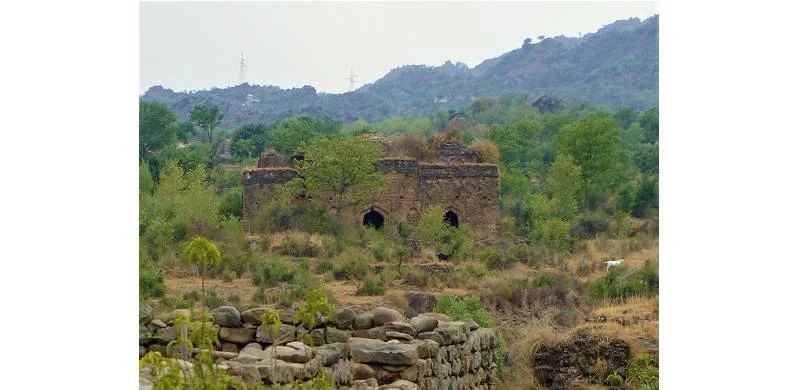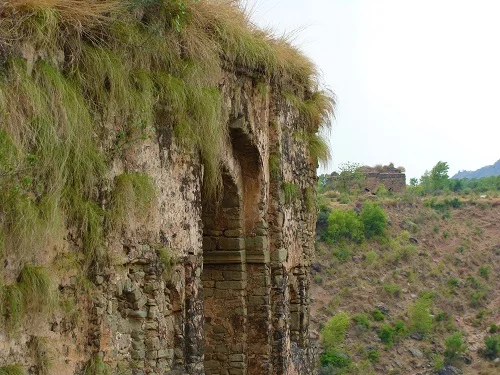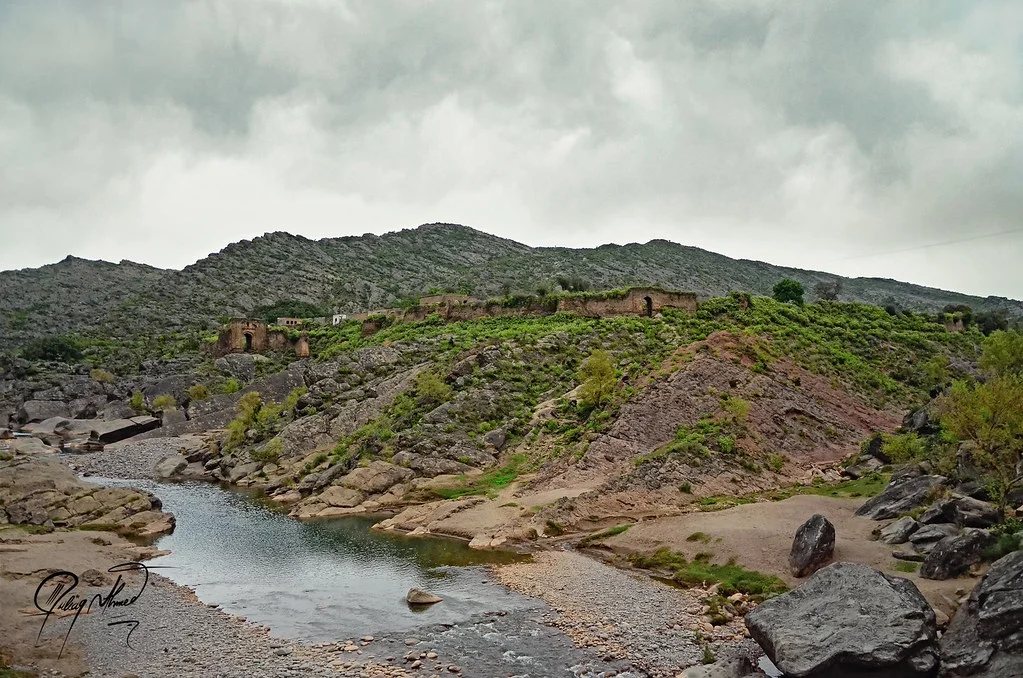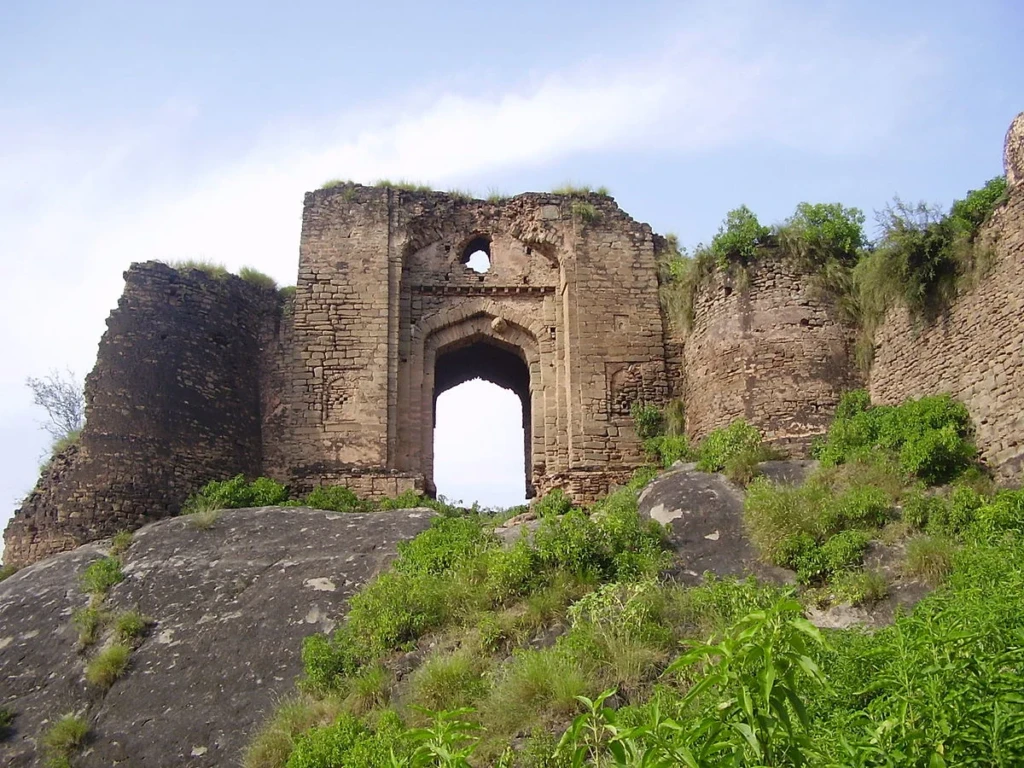INTRODUCTION

A mosque known as Mai Qamru Masjid was constructed by engraving a nearby mountain rock. The ancient Gakhar mosque, Mai Qamru Masjid is situated in Bagh Jogian, across from Pharwala Fort, the remains of this masjid can be seen today. The masjid offers a stunning view of the fort.
LOCATION
This mosque is located close to the right bank of the Sohan River, west of the Bagh Jogian settlement, and faces the stronghold of Pharwala on the left side.
Pharwala Qila, a fort, is located 30 kilometers northeast of Islamabad. The Gakhar village known as Bagh Jogian is located south of the fort, on the left bank of the Sohan River.
STRUCTURE

A remarkable example of Ghakkar architecture is the Mai Qamro mosque. Constructed with a rectangular layout, it is topped with three little domes. The mosque’s two other domes are in relatively decent shape, however, the southern dome has collapsed. Its three arched doorways are what makes it famous.
Two recessed arches surround the central entry, adding to the building’s remarkable beauty. A lovely cut-brick decoration may be found above the arched entryway. Nowhere else in Pothohar can one find such ornamentation. This mosque was built with dressed stone. It was once plastered with the mosque’s exterior still bears evidence of this.
CURRENT SITUATION
A portion of the masjid’s perimeter wall is still standing the test of time. The barrier to the north still exists. There are also evident remains of the eastern and southern walls. The mosque, which the people have converted into a barn for storage, is in terrible shape. Haystack bags can be found all over the mosque’s courtyard. There are gaps in the mosque’s western and northern walls. The southern arched entryway is likewise in disrepair.
HISTORY
The magnificent mosque was constructed in the 17th century AD by Nirwan Hamad Khan, also known as Hathi Khan, the Gakhar family’s monarch, in honor of his Begum.
This masjid, which stands directly in front of the Pharwala fort, is a firsthand account of the events that occurred surrounding the Gakhar dynasty’s rise and collapse, the brother-in-law’s adversary, the young men who died in rebellion, war and conflict, murder, and devastation.

It is neglected these days, and people are afraid that new communities will destroy it. The shrines of the Gakhar nation’s martyrs, as well as those of their heroic rulers, heirs, and families, who gave their lives for Islam and their beloved homeland, are located on the masjid’s grounds.
The final emperor of the Gakhar dynasty, Sultan Muqarrab Khan, is buried in a hexagon-shaped tomb at Bagh Jogian, just a short distance from the garden gate of Pharwala Fort. who, though still the most powerful sultan of the Gakhar dynasty in Pothohar, has a barely maintained tomb today. Another point of dispute around Sultan Muqarrab’s tomb was that, like a Hindu or Sikh samadhi, the architecture of the 18th century is precisely like that of Sultan Muqarrab’s tomb. Even those who explored for priceless treasures showed little regard for the tomb’s sacredness and seriously damaged both the interior decor and the tomb itself.
The Gakhar’s remains were severely damaged during the Sikh conquering, to the point that there is no history or record of the Gakhar during the Sikh era. It is possible that at this period the Bagh Jogians went through their worst moment and the Sikhs brutally killed the Ghakhas.

The remains of Gakhar cities, which the Sikhs demolished in the late eighteenth century, are mentioned by Mount Stewart Elphinstone in his book “Kingdom of Kabul”.
The Sikhs killed thousands of people at this time, and many others fled to far-off places to escape for their lives. Anand Singh Thiporia, the renowned Malla Singh Thiporia’s grandson, later conquered the whole area under Ranjit Singh’s rule and brought his countrymen to poverty and utter starvation.
These gardens provided the British with a superb and appealing hunting area during their rule. In the past, British army officers would mostly come here for camping and hunting. The Awan tribe, came to this area to provide labor during British control, and now there is a minor Awan population.
CONCLUSION
Mai Qamro, the wife of Hathi Khan Ghakkar, is thought to have constructed the mosque. The Ghakkar dynasty was one in which women had prominent and powerful roles. Although there is a lot of promise for tourism here, there is currently little protection, so guests should exercise caution. The Mai Qamro masjid at Bagh Jogian is one of the most notable of the several old, decaying buildings around Islamabad.



60 Comments
Olivewidly
маркетплейс аккаунтов соцсетей магазин аккаунтов социальных сетей
Peterdaw
маркетплейс аккаунтов соцсетей https://marketplace-akkauntov-top.ru/
RichardTen
профиль с подписчиками безопасная сделка аккаунтов
JamesCledo
купить аккаунт с прокачкой маркетплейс аккаунтов
Olivewidly
маркетплейс аккаунтов соцсетей перепродажа аккаунтов
Bryantbeini
площадка для продажи аккаунтов магазин аккаунтов
RichardTen
маркетплейс для реселлеров маркетплейс аккаунтов
DavidNaisk
Profitable Account Sales Account marketplace
JasonRah
Account trading platform Sell Pre-made Account
MichaelMibra
Social media account marketplace Account Exchange Service
WalterFlact
Verified Accounts for Sale Accounts market
JaredSoals
Account marketplace Website for Selling Accounts
BrianCoaps
Secure Account Purchasing Platform Account Market
Ronaldhex
Account Selling Service Account market
ThomasGat
Account Sale Secure Account Sales
BruceCUBOW
Verified Accounts for Sale Account Store
Williamsep
Buy Pre-made Account Sell Account
Ronaldhex
Account Acquisition Guaranteed Accounts
BrandonGuede
guaranteed accounts verified accounts for sale
EdmundDeats
account exchange service sell account
RomeoGaH
buy pre-made account socialaccountssale.com
DonaldSab
accounts for sale account buying service
Keithvet
account selling service https://accountsmarketbest.com/
RobertGeasy
website for selling accounts account market
Hectorwem
account trading sell pre-made account
Richardusero
database of accounts for sale ready-made accounts for sale
Carlosjeape
online account store secure account sales
Stephentraky
account buying service account trading platform
Stevenslace
sell pre-made account account purchase
Clydedoulp
database of accounts for sale sell pre-made account
JohnnyDot
website for buying accounts buy account
ThomasPouff
account catalog account selling platform
PhilipDib
account trading service account selling platform
RandalOxilt
account trading platform account catalog
RichardMouse
account selling platform accounts for sale
Zacharymax
account trading platform account catalog
Kevinjoipt
account catalog account trading
Raymondweiff
online account store marketplace-social-accounts.org
Thomasnussy
account trading platform https://accounts-market-soc.org
NathanKiz
account trading service ready-made accounts for sale
BruceObere
account catalog buy and sell accounts
Danielnot
account trading platform account selling service
Jasonvon
account exchange service https://accounts-buy-now.org
Geraldmox
guaranteed accounts account acquisition
ThomasBeada
account market account trading service
accounts-offer.org_Cousy
account selling platform https://accounts-offer.org
accounts-marketplace.xyz_Cousy
account selling service accounts-marketplace.xyz
buy-best-accounts.org_Cousy
accounts marketplace buy accounts
social-accounts-marketplaces.live_Cousy
guaranteed accounts social-accounts-marketplaces.live
accounts-marketplace.live_Cousy
website for selling accounts account marketplace
social-accounts-marketplace.xyz_Cousy
ready-made accounts for sale https://social-accounts-marketplace.xyz
buy-accounts.space_Cousy
secure account sales https://buy-accounts.space
buy-accounts-shop.pro_Cousy
account sale https://buy-accounts-shop.pro
buy-accounts.live_Cousy
secure account sales https://buy-accounts.live
social-accounts-marketplace.live_Cousy
purchase ready-made accounts https://social-accounts-marketplace.live
accounts-marketplace.online_Cousy
account market https://accounts-marketplace.online
accounts-marketplace-best.pro_Cousy
database of accounts for sale accounts market
akkaunty-na-prodazhu.pro_Cousy
маркетплейс аккаунтов https://akkaunty-na-prodazhu.pro/
rynok-akkauntov.top_Cousy
маркетплейс аккаунтов https://rynok-akkauntov.top
kupit-akkaunt.xyz_Cousy
магазин аккаунтов https://kupit-akkaunt.xyz/